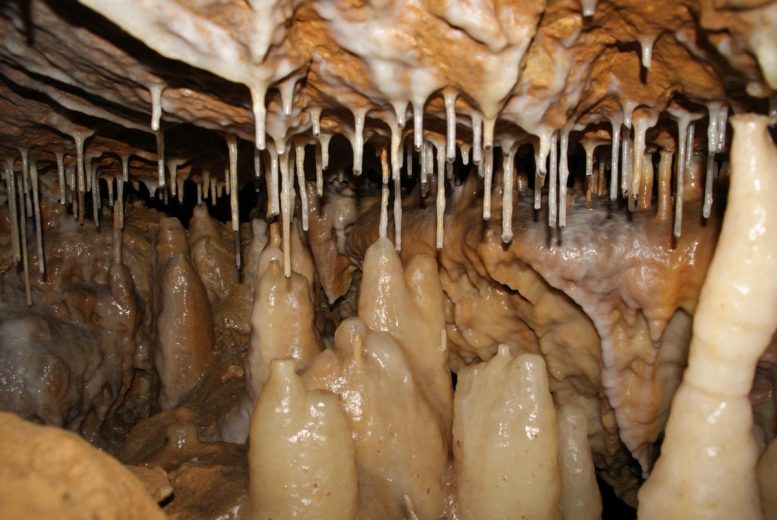
Active dripstone formation in a side area of the “Kleine Teufelshöhle.” Credit: KIT (taken as part of the HEiKA Project Check Extrema)
Researchers from Heidelberg and Karlsruhe use stalagmite for the reconstruction of regional and global climatic history.
Tree-ring data, when integrated with information from stalagmites, has enabled a team of researchers, including geoscientists from Heidelberg University and the Karlsruhe Institute of Technology, to access a distinctive archive for examining natural climate fluctuations over centuries.
The researchers analyzed the isotopic composition of oxygen in a stalagmite formed from calcareous water in a cave in southern Germany. In conjunction with the data acquired from tree rings, they were able to reconstruct short-term climate fluctuations over centuries and correlate them with historically documented environmental events.
Tree Rings and Short-Term Climate Analysis
Until now, short-term climate fluctuations over hundreds of years could be analyzed only by means of tree-ring records by combining independent measurements from a number of studies, explains geoscientist Dr. Tobias Kluge of the Karlsruhe Institute of Technology (KIT). The size of the tree rings, which varies by a few millimeters, provides information on the dynamics of seasonal precipitation, in turn pointing to climatic conditions in the specific growth period. According to Dr Kluge, summers with heavy rainfall are expected particularly in cold years, whereas very wet winters are expected in warm years.
In contrast to tree rings, stalagmites have only been used in exceptional cases to systematically measure climate data and their annual variations. The decisive factor is the rainwater infiltrating a cave, whose dissolved lime forms the stalagmites. This water comes from local precipitation in the cold and warm seasons, and each is characterized by a special isotopic composition of oxygen. From this, analyses can be derived indicating whether and in which years winter or summer precipitation dominated.
Case Study: Kleine Teufelshöhle Stalagmite
The researchers from Heidelberg and Karlsruhe studied a stalagmite – a dripstone that grows upward from the floor of a cave – from the “Kleine Teufelshöhle” in Franconian Switzerland. With a growth rate of one to four centimeters per millennium or an annual growth rate of about the width of a single hair, this stalagmite grew much more slowly than comparable ones.
The growth zones of the stalagmite are a hundred times thinner than a tree ring, so just a few centimeters can provide data on the climatic conditions over a thousand years. The composition of oxygen isotopes was measured using the ion probe at the Institute of Earth Sciences of Heidelberg University. “The analyses required precise measurements within the annual growth zones of just a few micrometers, which is possible only with this type of large-scale research device,” explains Prof. Dr Mario Trieloff, head of the Heidelberg Ion Probe laboratory.
Historical Climate Events Revealed by Stalagmite Data
The researchers report that the climate data acquired from the “Kleine Teufelshöhle” stalagmite revealed regional as well as global environmental events. The unusually cold year of 1816, which went down in history as the Year Without a Summer, stemmed from an eruption of the Tambora volcano in Indonesia in April of 1815, possibly exacerbated by a hitherto unknown volcanic eruption six years before. The data from the stalagmite measurements show that summers were cold and winters very wet during this time, which combined with year-round flooding led to poor harvests and famine.
The information stored in the stalagmite also provides evidence of long-term climate fluctuations such as the Little Ice Age, whose core period began at the end of the 16th century and lasted until the late 17th century. According to the researchers, this period was marked by frequent flooding, which is historically documented in the city of Nuremberg not far from the “Teufelshöhle”.
The climate data from the cave was verified using a tree-ring archive from the vicinity. The data point to cold dry winters that delayed the annual ice and snow melts, leading to major short-term floods with catastrophic consequences, explains Dr Kluge from the Institute of Applied Geosciences at the KIT.
Reference: “Assessment of climate extremes at the regional scale during the last millennium using an annually resolved stalagmite record” by Tobias Kluge, Philipp Holz, Thomas Neumann, Elisabeth Eiche, Maximilian Schuh, Norbert Frank, Ronny Friedrich, Alexander Land, Mario Trieloff and Axel K. Schmitt, 4 November 2023, Earth and Planetary Science Letters.
DOI: 10.1016/j.epsl.2023.118458
Along with the scientists from Heidelberg and Karlsruhe, researchers from Berlin, Hohenheim, and Mannheim participated in the investigations.









When I was exploring Caves in the 1960’s and 1970’s I Has suggested that we could core cave formations along their longitudinal axis, and take the core and grind a spray of
formation materials and determine what unusual materials are incorporated in the individual layers. However, about that time there was a lot of stealing and selling
cave formations so Congress enacted the Cave Protection Act, which precluded coring
formations in the US. Since Stalagmites grow at around 5,000 Year to an Inch, or 60,000 years to a foot, and the formation I wanted to core was 105 feet tall. That is a minimum of 6.3 million years of information stored in one Stalagmite in One Cave in the Guadaloupe Mountains in Southern New Mexico. Since cores can now be far smaller in diameter, and New Technology Can Use Femto-second Laser Ablation to get Plasma Vapor,
and Analyse it for Unusual Elements, and Compounds, then the New Trick will be to create
a Stalagmite and Stalactite Equivalent of ” Dendro- Chronology ” , but this Chronology will be hundreds of millions of years long, and give climate data, vegetation data, dust data, volcanic data, impact event data, and even more. Just Core, Put in a Mico chip that plugs the hole, and gives all the information about that core, and where it is stored, and what publications are recording the information. The history of the Earth for the last few million years is written in the Books of cave formations, one five thousandth of an inch per page.